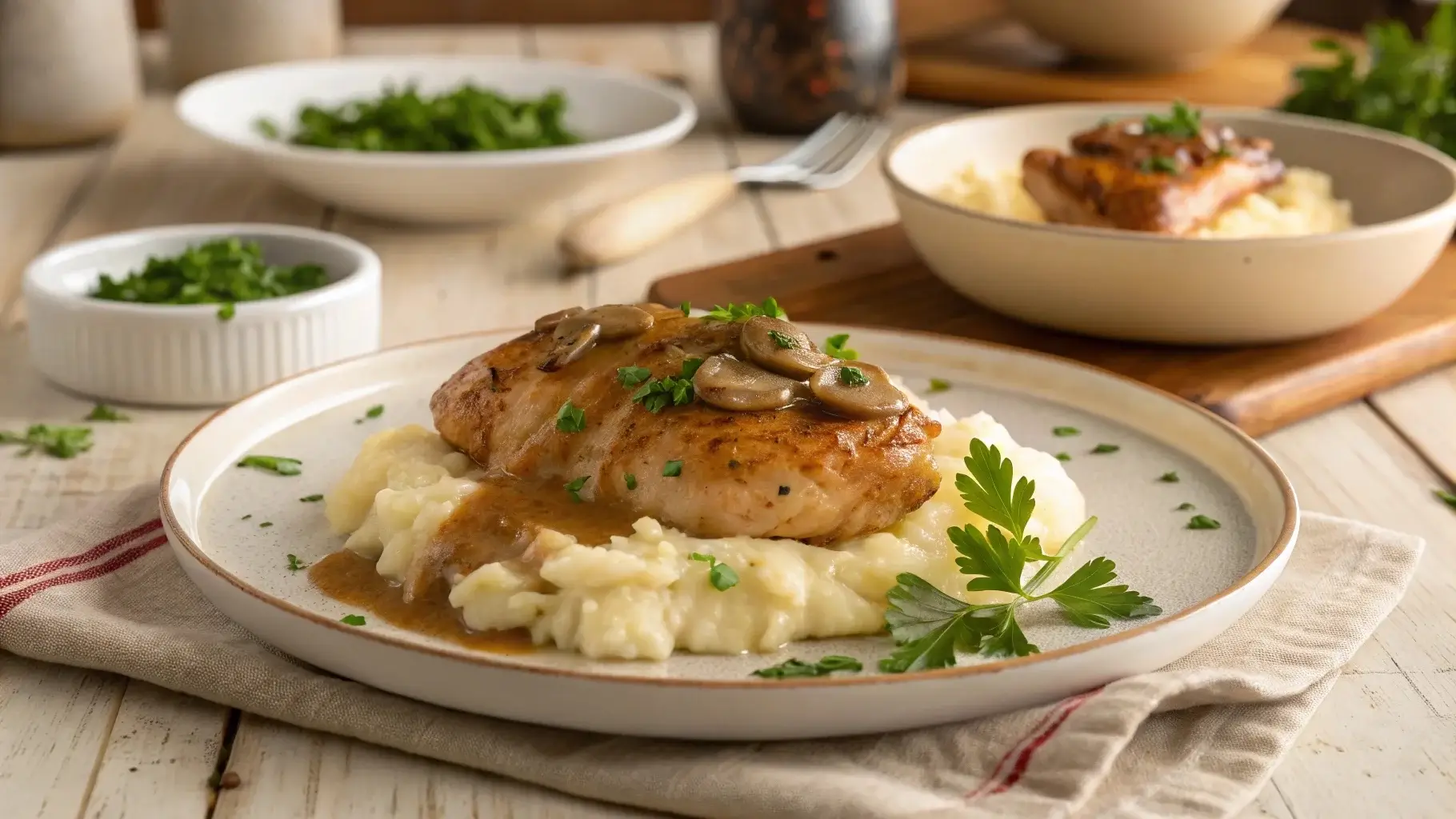There’s something magical about the smell of chicken sizzling in a pan and the rich, savory aroma of gravy slowly bubbling on the stove. Whether served over fluffy mashed potatoes or paired with biscuits, the combination of chicken and gravy is comfort food at its finest. It’s hearty, flavorful, and surprisingly easy to make once you master a few essential techniques. In this guide, we’ll explore everything you need to know, from selecting the right chicken to perfecting a velvety gravy. Along the way, we’ll cover variations, health-friendly alternatives, and expert tips to help you create a meal that satisfies every craving.
I still remember my first attempt at making this dish with Momo. We were craving something cozy, but with only a few ingredients left in the kitchen, it seemed like an impossible task. However, with some chicken thighs and a bit of creativity, we managed to whip up a delicious dinner that filled the kitchen with the smell of home-cooked goodness. Of course, Momo had his fair share of fun whisking the gravy—most of it splattered across the counter, but it was worth it! That night, our impromptu experiment turned into a meal we’ve recreated many times since. Let’s dive into how you can make this dish a staple in your kitchen.
Table of Contents
Introduction to Chicken and Gravy
Why Chicken and Gravy Is the Ultimate Comfort Food
There’s a reason this dish is a classic in homes around the world. The combination of juicy chicken and rich gravy creates a meal that’s warm, filling, and deeply satisfying. While many associate it with Southern cuisine, variations of this dish can be found in countries like France (Poulet à la Crème) and the UK, proving its universal appeal.
A Dish You Can Customize to Your Taste
One of the best parts about a chicken and gravy recipe is its adaptability. You can use different cuts of chicken—bone-in thighs for richer flavor or boneless breasts for a leaner option. The gravy can be thick and creamy or light and broth-based, depending on your preference. No matter how you make it, this meal delivers maximum flavor with minimal effort.
To master a velvety gravy texture, check out this quick guide to perfect brown gravy.
Essential Ingredients for Chicken and Gravy
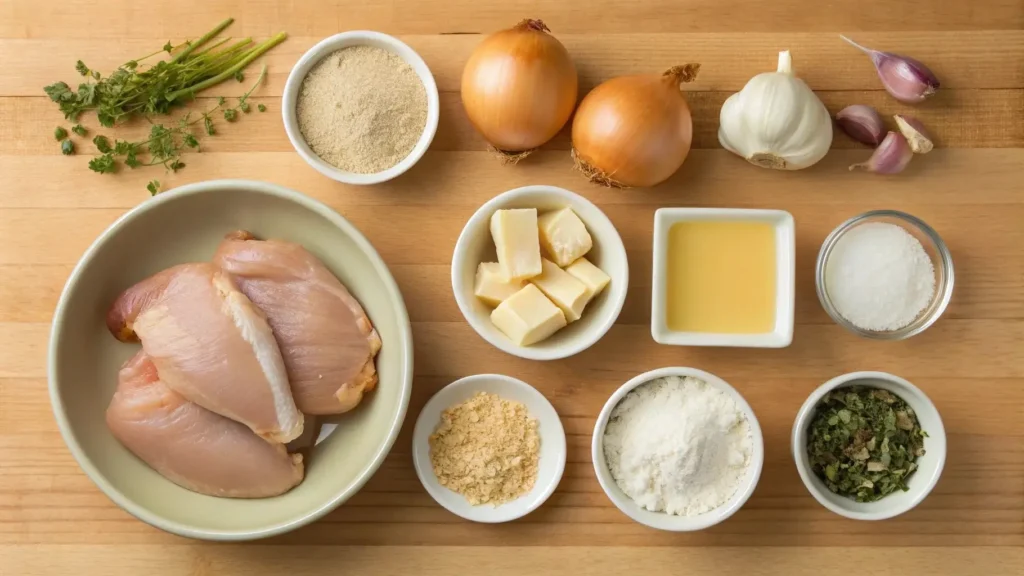
Choosing the Right Cut of Chicken
The success of any great chicken and gravy recipe starts with choosing the perfect chicken cut. Bone-in chicken thighs are often preferred for their juicy texture and rich flavor, but you can also use boneless breasts or drumsticks if you prefer a leaner option. If you’re short on time, pre-cooked rotisserie chicken is a convenient alternative that absorbs gravy beautifully.
The Heart of a Flavorful Gravy
A rich, homemade gravy is the soul of this dish. The base usually includes chicken stock or broth, enhanced with the drippings left in the pan after cooking the chicken. To achieve a thick, velvety consistency, you’ll need a thickening agent—either flour, cornstarch, or a traditional roux made with butter and flour. For deeper flavors, garlic, onions, thyme, and rosemary can work wonders, while a splash of cream can make the gravy extra indulgent.
Seasonings to Build Layers of Flavor
Salt and black pepper are essential, but don’t stop there! Smoked paprika, cayenne pepper, or even Dijon mustard can add complexity to your gravy. Herbs like bay leaves and parsley elevate the dish, creating a balance between the savory chicken and the luscious sauce.
Pro Tip: Always taste your gravy as you go. A little seasoning adjustment can transform a good gravy into an unforgettable one.
Step-by-Step Classic Chicken and Gravy Recipe
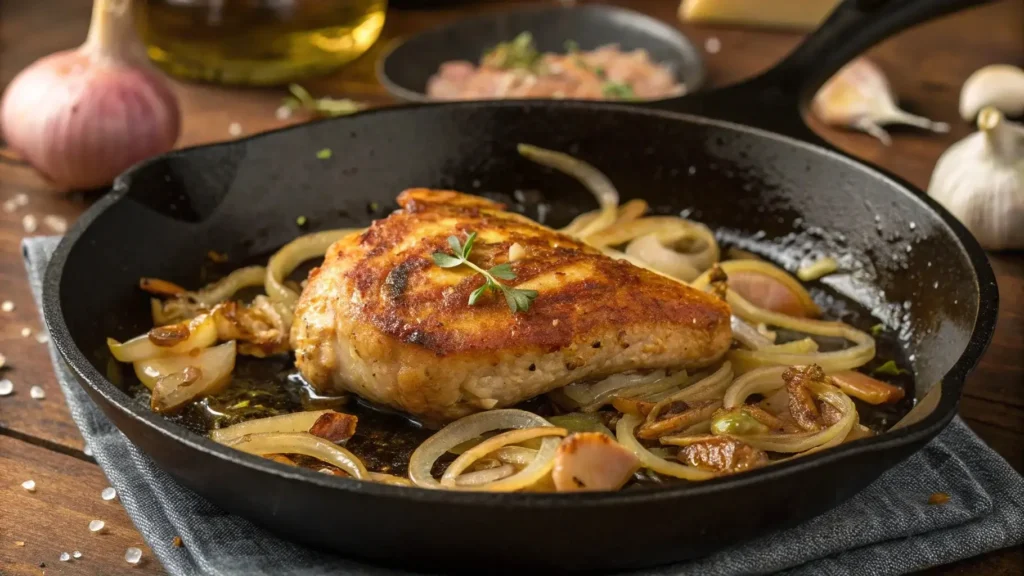
Step 1: Preparing and Cooking the Chicken
- Start by seasoning the chicken generously with salt, pepper, and any additional spices like paprika or thyme.
- Heat a large skillet over medium heat and add a drizzle of oil or a knob of butter.
- Place the chicken in the pan skin-side down and cook for 5-7 minutes until golden brown. Flip and cook for another 5 minutes. If using bone-in chicken, consider finishing it in the oven at 375°F (190°C) for 15-20 minutes to ensure thorough cooking.
Step 2: Creating the Gravy Base
- Once the chicken is cooked, transfer it to a plate and cover it with foil to keep warm.
- In the same skillet, add a tablespoon of butter and cook finely diced onions and garlic until fragrant.
- Sprinkle 2 tablespoons of flour over the onions and stir continuously to form a roux. Cook for 1-2 minutes to remove the raw flour taste.
- Slowly whisk in 2 cups of chicken broth, scraping the bottom of the pan to release any flavorful bits. Continue whisking until the mixture thickens.
Step 3: Combining Chicken and Gravy
- Return the chicken to the skillet and spoon the gravy over it.
- Simmer on low heat for 5-7 minutes, allowing the chicken to soak up the flavors. If the gravy becomes too thick, add a splash of broth or milk to reach your desired consistency.
- Adjust seasoning with salt, pepper, and a touch of lemon juice to brighten the flavors.
Step 4: Serving Suggestions
- Serve the chicken and gravy over a bed of fluffy mashed potatoes, rice, or buttered noodles. Garnish with fresh parsley for a pop of color and extra flavor.
This step-by-step approach ensures that your chicken and gravy recipe turns out delicious every time, making it an ideal meal for family dinners or special gatherings.
Slow-Cooker Chicken and Gravy Variation
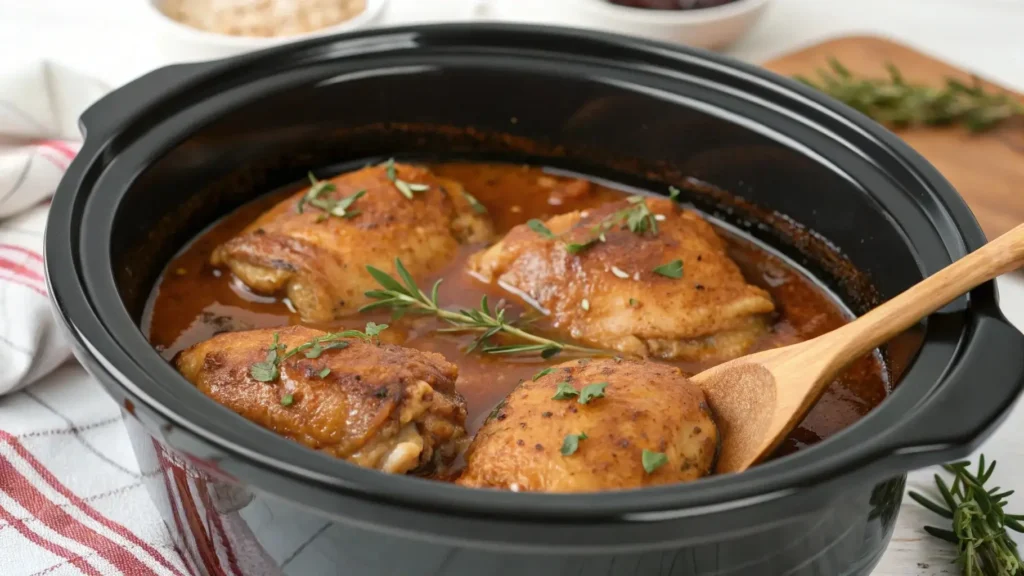
Why Choose the Slow Cooker for This Dish?
A slow cooker offers convenience without compromising flavor, making it an excellent option for creating a tender, flavorful chicken and gravy recipe with minimal effort. Cooking the chicken slowly allows the meat to absorb the rich gravy while staying moist and juicy. Plus, you can set it and forget it, freeing up time for other tasks.
Step-by-Step Slow-Cooker Chicken and Gravy
- Layer the Ingredients: Begin by seasoning bone-in chicken thighs or breasts with salt, pepper, garlic powder, and paprika. Place them at the bottom of the slow cooker.
- Add Aromatics and Broth: Sprinkle diced onions, minced garlic, and a bay leaf over the chicken. Pour in 2 cups of chicken broth to keep the dish moist and enhance its flavor.
- Cook Low and Slow: Set the slow cooker on low for 5-6 hours or high for 3-4 hours. The chicken will cook gently, soaking in the flavors of the broth and seasonings.
- Thicken the Gravy: Once cooked, remove the chicken and set it aside. In a small bowl, whisk 2 tablespoons of cornstarch with water, then stir it into the broth. Let the slow cooker run on high for 10-15 minutes until the gravy thickens.
- Serve and Enjoy: Return the chicken to the slow cooker, allowing it to warm in the gravy before serving over mashed potatoes or rice.
Tips for Amateur and Advanced Cooks
For Amateur Cooks
- Pre-cooked chicken saves time: If you’re new to cooking, start by using rotisserie chicken to simplify the process. Just warm it in the gravy for a quick meal.
- Keep the gravy simple: Stick to a basic roux of butter and flour, and gradually add chicken broth while stirring to avoid lumps.
- Taste as you go: Season your chicken and gravy throughout the process. A pinch of salt or pepper can elevate the flavor.
- Don’t skip deglazing: After cooking the chicken, scrape up those flavorful brown bits from the pan with a bit of broth—they’re the secret to a rich, savory gravy.
- Use fresh herbs for garnish: A sprinkle of parsley or thyme at the end makes your dish look and taste restaurant-worthy.
For Advanced Cooks
- Make homemade stock: Simmer chicken bones, onions, carrots, and celery to create a deeply flavorful broth for your gravy.
- Enhance with wine: Deglaze the pan with white wine or sherry for added depth and a hint of sweetness.
- Experiment with spices: Add a pinch of cayenne, smoked paprika, or mustard powder to give your gravy a unique twist.
- Try braising for more flavor: Sear the chicken first, then braise it in the gravy for an hour to create tender, fall-apart meat.
- Finish with a luxurious touch: Stir in a small pat of butter or a splash of cream at the end for a glossy, rich finish.
With these tips, both beginners and pros can elevate their chicken and gravy recipe, making every meal a memorable one.
Lighter, Healthier Chicken and Gravy Options
Low-Fat Gravy Swaps
If you want to enjoy the rich flavors of a chicken and gravy recipe while keeping it light, consider swapping out heavy ingredients for healthier alternatives. Replace butter with olive oil or use low-sodium chicken broth as the base. Instead of making a traditional roux with butter and flour, use a cornstarch slurry for a low-fat thickener. Adding a splash of unsweetened almond milk or Greek yogurt can create creaminess without the extra calories.
Lean Protein Options
Using skinless chicken breasts or turkey breast instead of thighs can significantly reduce fat content while still providing plenty of protein. Another option is to poach or bake the chicken instead of frying it in oil. If you prefer a plant-based twist, you could even try grilled tofu or chickpea-based “chicken” in the gravy for a vegetarian-friendly meal.
Flavorful Add-Ins Without the Extra Calories
To enhance flavor without relying on fat, add fresh herbs like rosemary or thyme, along with spices like garlic powder or paprika. A dash of lemon juice or apple cider vinegar at the end of cooking brightens the dish and adds depth.
Common Mistakes to Avoid When Making Chicken and Gravy
Even the most seasoned cooks can run into challenges when making a chicken and gravy recipe. Avoiding these common mistakes can ensure your dish turns out flavorful, tender, and perfectly balanced every time.
Overcooking or Undercooking the Chicken
One of the biggest pitfalls is overcooked or dry chicken. To prevent this, monitor your cooking time closely and use a meat thermometer. Chicken should reach an internal temperature of 165°F (75°C). If you’re using bone-in pieces, consider searing them first and finishing them in the oven to retain moisture. On the flip side, undercooked chicken can leave you with a rubbery texture and food safety concerns, so always double-check doneness.
Lumpy or Watery Gravy
A lumpy gravy can ruin the texture of your dish, but it’s easy to fix with a few techniques. Gradually whisk in the flour or thickening agent while stirring continuously. To fix existing lumps, strain the gravy through a fine-mesh sieve or blend it with a hand mixer. On the other hand, if your gravy is too thin, whisk in a slurry made of flour or cornstarch and water.
Underseasoning the Gravy
A bland gravy can make even the juiciest chicken taste dull. Always taste and adjust seasonings throughout the cooking process. Layer in flavors using garlic, onions, herbs, and spices, and finish with a dash of black pepper or a splash of vinegar to bring everything together.
By avoiding these common mistakes, you’ll consistently achieve a smooth, delicious chicken and gravy recipe your family will love.
Serving Tips for Chicken and Gravy
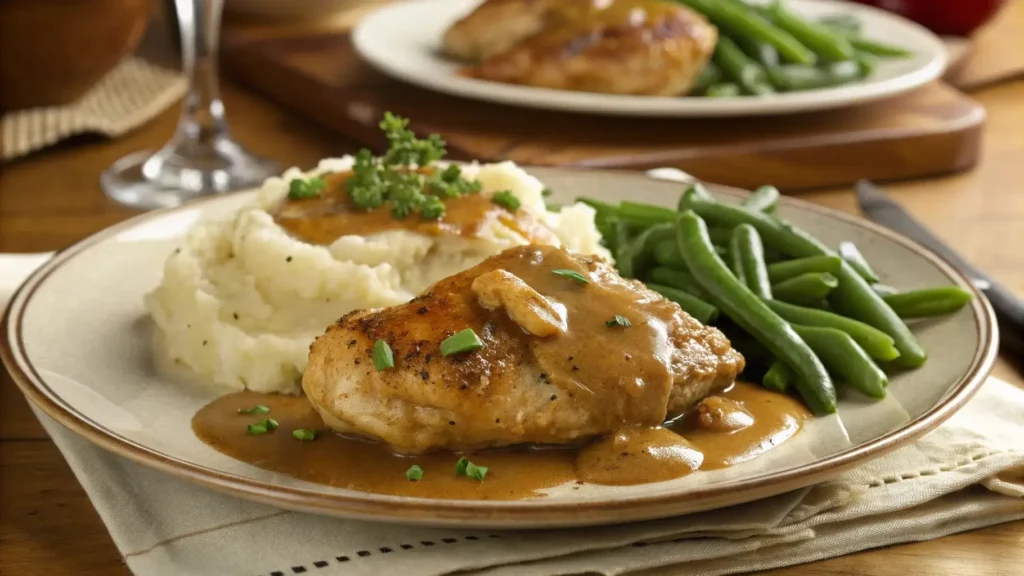
For the Perfect Presentation
A chicken and gravy recipe is not only about flavor but also about presentation. To create a visually appealing dish, start by placing your chosen base—mashed potatoes, rice, or noodles—on the plate. Next, gently place the chicken on top, and spoon the rich, golden gravy over the chicken and base. Garnish with a sprinkle of freshly chopped parsley or thyme to give the dish a pop of color. For added elegance, a few grinds of black pepper can add a gourmet touch.
Portioning and Serving Size
When serving this hearty dish, portion sizes matter. One medium chicken breast or two bone-in thighs per person is typically sufficient, depending on the appetites of your guests. If serving a family meal, present the dish on a large platter and let everyone help themselves.
Serving Tips for Special Occasions
For special dinners or holiday gatherings, consider serving the chicken and gravy in a rustic cast-iron skillet to create a warm, homey presentation. Alternatively, serve individual portions on decorative dinner plates with a small gravy boat on the side, allowing guests to customize their portions.
Leftovers Serving Idea
Transform leftovers into a hearty open-faced sandwich by layering shredded chicken and gravy on toasted bread and topping it with a fried egg or sautéed mushrooms.
These tips ensure that your chicken and gravy recipe is as delightful to present as it is to eat.
Popular Pairings for Chicken and Gravy
A well-made chicken and gravy recipe deserves the perfect side dishes to complement its rich, savory flavors. Whether you’re hosting a holiday dinner or preparing a cozy family meal, these pairings will elevate your dish.
Classic Starches for Soaking Up Gravy
- Mashed Potatoes: Creamy mashed potatoes are the traditional companion to chicken and gravy. The fluffy texture absorbs the rich sauce, creating a satisfying bite every time.
- Rice or Quinoa: For a lighter option, serve the chicken over rice or quinoa. Both grains soak up the gravy without adding heaviness to the meal.
- Buttered Noodles: Wide egg noodles with a bit of melted butter and parsley provide a hearty, comforting base.
Vegetables to Balance the Meal
- Steamed Green Beans: Their fresh, crunchy texture pairs well with the richness of the gravy.
- Roasted Carrots or Brussel Sprouts: The caramelized sweetness of roasted veggies offers a delightful contrast to the savory chicken.
- Sautéed Spinach: A quick and easy side that adds a healthy touch and balances the meal with its slightly bitter undertones.
Breads for Sopping Up Every Drop
- Buttermilk Biscuits: Soft, fluffy biscuits are perfect for soaking up the gravy.
- Crusty Bread: A warm slice of crusty bread adds texture and ensures no gravy goes to waste.
With these pairings, you can transform your chicken and gravy recipe into a complete meal that satisfies any craving.
Storage, Reheating, and Freezing Chicken and Gravy
Storing and reheating your chicken and gravy recipe correctly can help you enjoy leftovers that are just as tasty as the first bite. Whether you’re meal-prepping or saving leftovers from a family dinner, proper techniques make all the difference.
Storing Leftovers Safely
Once the chicken and gravy have cooled to room temperature, transfer them to an airtight container. Separate the chicken from the gravy, if possible, to maintain the best texture. Store in the refrigerator for up to 3-4 days. For longer storage, place the leftovers in freezer-safe containers and freeze them for up to 3 months.
Reheating for Best Flavor
- Stovetop Method: Heat the chicken and gravy in a pan over medium heat, stirring frequently to prevent sticking. Add a splash of chicken broth if the gravy is too thick.
- Microwave Method: If you’re short on time, you can microwave the leftovers. Cover them with a damp paper towel to retain moisture and heat in 1-minute intervals, stirring in between.
- Oven Method: For larger portions, preheat the oven to 350°F (175°C) and warm the chicken and gravy in a covered dish for 15-20 minutes.
Tips for Freezing and Thawing
When freezing, label the container with the date. Thaw frozen leftovers overnight in the fridge before reheating to maintain the best texture.
By following these steps, you’ll ensure your chicken and gravy recipe stays flavorful, whether enjoyed fresh or as a leftover meal.
Chicken and Gravy Recipe Variations from Around the World
The classic chicken and gravy recipe is loved worldwide, but it’s far from the only version. Many countries put their own spin on this comforting dish, adding unique flavors and techniques.

Southern Fried Chicken with Cream Gravy
A popular comfort food in the Southern U.S., this variation involves crispy fried chicken served with a creamy, peppery gravy made from pan drippings. The combination of crunchy chicken and silky gravy is both indulgent and satisfying.
French Poulet à la Crème
The French version takes things up a notch with a creamy sauce made from white wine, heavy cream, and mushrooms. The chicken is often pan-seared or roasted, then simmered gently in the sauce for a luxurious finish. Serve this variation with buttery mashed potatoes or crusty bread.
Asian-Inspired Soy Gravy Chicken
For an Asian twist, use soy sauce, ginger, garlic, and a bit of brown sugar to create a savory-sweet gravy. Instead of traditional chicken stock, you can use a mix of chicken broth and soy-based sauces for a deeper flavor. This variation pairs wonderfully with steamed rice and stir-fried vegetables.
Italian Chicken Marsala
Although technically not labeled as “gravy,” this variation uses a sauce made from Marsala wine, mushrooms, and garlic, creating a rich and flavorful dish that’s perfect over pasta or polenta.
By trying different variations, you’ll discover how this humble dish can transform into something extraordinary with just a few ingredient swaps.
Frequently Asked Questions (FAQ)
1. Can I use boneless chicken for this recipe?
Yes, boneless chicken breasts or thighs work well for a chicken and gravy recipe. However, bone-in pieces often provide more flavor due to the juices released during cooking.
2. What’s the best way to thicken gravy without flour?
Cornstarch is a great alternative to flour. Mix 1-2 tablespoons of cornstarch with water to create a slurry, then stir it into the hot gravy until it thickens. Arrowroot powder and potato starch also work as substitutes.
3. Can I make this recipe gluten-free?
Absolutely! Simply replace regular flour with a gluten-free alternative like cornstarch or a gluten-free all-purpose flour blend. Be sure to check that any broth you’re using is also gluten-free.
4. How do I fix gravy that’s too salty?
To reduce saltiness, add a splash of heavy cream or a small amount of unsalted chicken broth to dilute the flavor. Alternatively, you can stir in a boiled potato and remove it after it absorbs the excess salt.
